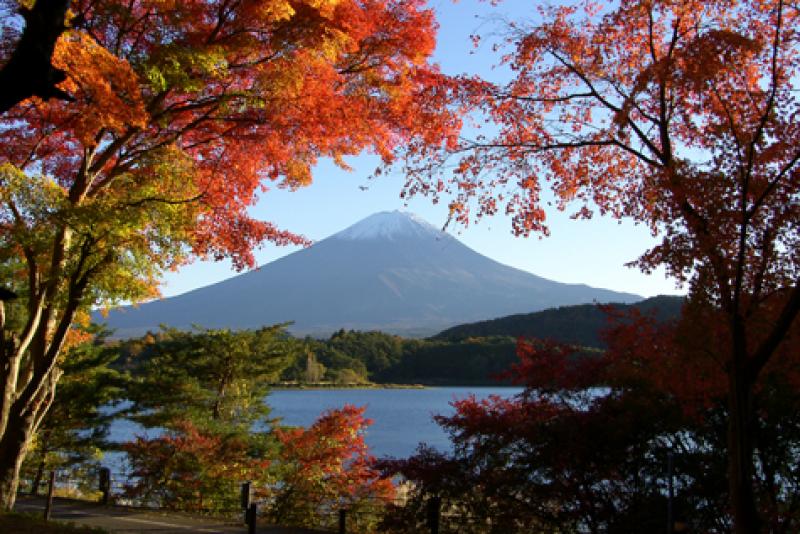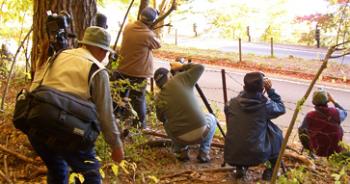The Momiji Tunnel and Mt. Fuji
This item appears on page 32 of the July 2017 issue.
We’d like to say a bit more about the Momiji Tunnel in Kawaguchiko in Japan, mentioned in our letter “Mt. Fuji from Hotel New Century” (Dec. ’16, pg. 49), and clarify that the traveling we did through the “tunnel” was on foot.
Having missed seeing Mt. Fuji on a March 2014 stay in the town of Kawaguchiko (aka Fujikawaguchiko), due to three days of solid clouds and fog, we were determined to get it right that autumn.
So, during a visit in November, we planned a day trip from Tokyo, we made sure that the weather forecast promised a clear day, and we checked the live-cam feeds from Kawaguchiko (the name of both the town and the lake; ko means “lake”) to be sure the weather forecasters had gotten it right (www.fujigoko.tv/english AND www.yamanashi-kankou.jp/fujisan watcher/live/index.html).
We left our hotel in Ueno in Tokyo about 9:20 a.m. Using our JR Rail Passes, we took JR trains to Otsuki on the JR Chuo Line, then changed to the Fujikyu Railway Line, a private line to Kawaguchiko.
We wanted to go to the so-called Momiji Tunnel to see Mt. Fuji framed by the gorgeous autumn colors of momiji (maple foliage). We had done our homework and learned that we should take the Red Line tourist bus to stop No. 22 at Oishi Park, the last stop, then walk another 20 minutes or so. (No bus route runs along the lakeshore road past the Momiji Tunnel.)
Hoping to find a way to get even closer to our destination, we talked to the volunteers in the tourist information office at the Kawaguchiko rail station.
The Momiji Tunnel is plainly marked on tourist maps, but the staff were uncertain how to get there from the last stop on the bus line, were concerned that we were too elderly to walk for 20 minutes each way and, most of all, wanted us to go instead to the town’s Momiji Festival at the Maple Corridor, some two miles shy of the Momiji Tunnel.
We decided to push ahead with what we knew. We caught the Red Line bus just outside the train station, stayed aboard past the many other stops (most with touristic significance) and alit at stop 22, Oishi Park. The park is a popular destination in season, but most of the flowers were gone by that time.
There were views of Fuji from the park, but we were confident that better was ahead, so we struck off west through the park and the adjacent Kawaguchiko Natural Living Center till we joined the sidewalk along Route 21, the lakeshore drive, called the Kohoku View Line.
At first, the road passed inland from the lake past handsome lakeshore properties, but it soon emerged to the shoreline, with the sidewalk nearer the water. In about 25 minutes (including many stops for photos), we were within sight of the Momiji Tunnel, a little under a mile from our start at Oishi Park.
The Momiji Tunnel is not a tunnel in the sense of a hole bored through a mountain. It is not even a canopy of overarching trees, although there is a stretch of about 400 feet where trees do hang sparsely over the road. It is not a tunnel at all, in fact.
The Momiji Tunnel takes its name from Japanese photographers’ love of framing subjects of their shots (a temple or shrine, for example) with available natural forms (an arch of flowers, lights, etc.). These are called “tunnel shots” because each subject appears to be seen through the mouth of a tunnel.
As for the Momiji Tunnel — a grove of maples stretched across several hundred feet along the base of a steep hill — the consensus is that the location provides one of the best angles from which to center Mount Fuji, across Lake Kawaguchi, in a frame of maple leaves.
The dense grove, tucked between the hill and the lakeside road, offers many opportunities to frame Fuji-san in spaces between the boughs. In fact, many of the commercial shots of Fuji used in ads and articles are shot from this location.
Although we saw no sign on the road to announce we had arrived, it was clear we were there. Cars were parked randomly along the road, and amongst the trees we saw photographers setting up tripods.
We crossed from the sidewalk into the grove and made our way through the open woods of tall trees until we found the best spot. Unfortunately, everyone else thought it was the best place too. There were half a dozen cameras on tripods with photographers waiting for just the right light conditions to make the pictures they had so carefully arranged.
Happily, there was a spirit of camaraderie, with people eventually swapping places, and with a bit of patience we were able to get what we had trekked there for.
It was late afternoon by the time we left. We caught the bus at Oishi Park and decided to stop on the way back to see what the Momiji Corridor was all about.
While the Momiji Tunnel is a little patch of wild woods, the Momiji Corridor is a more urban walk along a pretty little stream confined in a concrete trough meant to contain spring flooding. There are rows of maples on either side — pretty enough in their way but too citified for our tastes. The trees of the Corridor are lighted at night during the festival, and there are food and handicrafts booths.
It should be noted that Internet searches for the Momiji Tunnel, the Momiji Corridor, the Maple Tunnel or the Maple Corridor can be very confusing. It appears that many tourists who reach the Corridor think they have reached the Tunnel, and they label their photographs incorrectly.
By the time we had a quick look at the Momiji Corridor, it had grown too dark for photography and was getting chilly. We squeezed onto a bus packed with day-trippers like us and reversed our outbound journey back to Kawaguchiko Station and Ueno Station.
We then picked up something for dinner from the nearby Lawson's convenience store and stumbled, exhausted, into our hotel room at 9:07. It had been a very full day but was well worth it.
JANE B. & CLYDE F. HOLT
Hinesburg, VT


